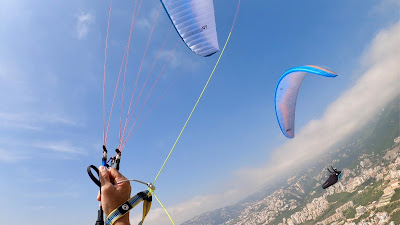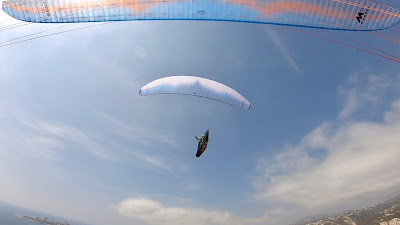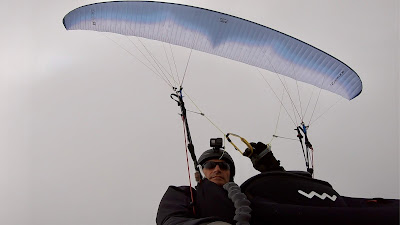Ozone Zeolite S | First impressions (Stall)
Details
Ozone Zeolite S | First impressions (Stall)
Ozone Zeolite – Red Bull X-Alps Schirm – Gesamt 5,5 kg 🙂
Die Ausrüstung für die X-Alps 2019 wiegt mit Schirm, XC-Gurtzeug und Rettung unter 5,5 kg. Der Zeolite selbst bringt gerade mal 2,85 kg auf die Waage. Er wurde speziell für das X-Alps Rennen entwickelt, das heißt für kleine und nicht unbedingt gute Startplätze, technische Top-Landungen, kleine und eingeschränkte Landebereiche und harte alpine Bedingungen.
Das R&D Team sagt dazu: „vergiss alles, das du glaubst über Kompromisse im 2-Leinen Design zu wissen. Der Zeolite ist einfach zu starten, in kleinen/eingeschränkten Landebereichen einfach zu landen, und verfügt über die angenehmste B-Kontrolle, die wir kennen. Das ist ein völlig neues 2-Leiner Design.“
In den kommenden Wochen werden wir weitere Infos zu dieser spannenden Ausrüstung veröffentlichen, und wir wünschen allen in diesem Jahr teilnehmenden Athleten für dieses Rennen viel Glück.
Vielen Dank an Manuel Nübel für diesen Bericht.
Quelle: https://www.flyozone.com/paragliders/de/news/a-peek-at-the-zeolite
TESTREPORT BASSIL ZIAD: THANK YOU
OZONE Zeolite GT MS
Red Bull X-Alps 2019 Paragliding.TV
Red Bull Xalps 2019 official video
How we define the route
Ahead of next month’s Red Bull X-Alps route announcement, we talk to race director Christoph Weber and safety director Jürgen Wietrzyk for the inside story on how the Turnpoints are selected.
Why have Turnpoints? Wouldn’t it be more fun without them?
JW: The purpose of a Turnpoint is simply to have a given direction for the race. Of course, we could say the route is from Salzburg via Mont Blanc to Monaco. But Turnpoints make the race more structured, force athletes to make different plans and find smart and new tactics from race to race.
What makes a good Turnpoint?
JW: The only fixed criteria a Turnpoint has to have is that it’s located somewhere in or along the Alps, this fascinating mountain range which stretches 1,200 kilometres from Austria to Monaco. Unfortunately, we cannot influence restricted flying zones. If we could, we would probably remove them every year. But the airports are not happy with this suggestion!
CW: We look for a challenging and interesting route. The Turnpoints should bring the athlete to interesting and nice spots in the Alps. We try to put them in a way that ensures restricted airspaces are not on the course line and we try to avoid restricted flying zones in general – but there are so many!
“The Red Bull X-Alps is more than a paragliding competition, it’s an adventure race.”
Whose benefit are Turnpoints for – athletes or fans?
JW: Turnpoints give fans the opportunity to meet the athletes, that’s one reason why some are on the ground, some in the air.
CW: Turnpoints [exist] as a guideline to get an interesting and exciting course and to give the fans the chance to meet the athletes.
Do you try to put in specific challenges like high mountains or lakes to cross?
JW: Every Turnpoint opens a certain range of different routes, and each route includes specific risk potentials. For example, in 2017 we had Monte Baldo, which meant that most of the athletes crossed Lake Garda in the air. We were happy to be supported by the local paragliding club and water rescue teams for managing this. But it’s not an intention to create this kind of risk.
But, the Red Bull X-Alps is more than a paragliding competition, it’s an adventure race. And that means that we all – organisers, fans, and athletes themselves – want to face mountain climbs, glacier hikes and big mountain crossings, not just the most economical and fastest route from Salzburg to Monaco.
CW: We try to have exciting Turnpoints and that means that sometimes there are these kinds of obstacles.
Is there a temptation to make the course longer every edition?
CW: Yes, it’s tempting, but it’s not a must.
Why are there more Turnpoints at the start and not so many at the finish?
JW: The last section – let’s say the range roughly along the western side of the border between Italy and France, is more or less a sprint to the finish, where the focus is on reaching the goal, not so much on tagging another Turnpoint. There is not much room for tactics any longer, there is only the goal, and everybody just wants to get there as fast as possible.
CW: The bigger the distance between the Turnpoints, the greater is the variation of the possible options.
Is there a perfect number of Turnpoints?
JW: The number depends on how long the route should be, and where the journey should go – and this again depends on the unknown wishes of athletes, fans, sponsors and everybody else who follows the race and is curious about what will happen from 16th June 2019 on Red Bull X-Alps Live Tracking.
To find out where that will be, tune in to our channels on March 12 when we reveal the 2019 Red Bull X-Alps route.
Leave a Reply
You must be logged in to post a comment.






